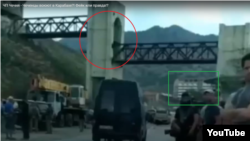On October 4, a short, jumpy video was released to social media purporting to show Chechen fighters in the conflict zone around Azerbaijan’s Nagorno-Karabakh region.
The video came just days after a September 29 Instagram post by Elkhan Suleimanov, the health minister of Russia’s North Caucasus region of Chechnya and a native of Azerbaijan, expressing support for Azerbaijan in the escalated fighting with neighboring Armenia and ethnic Armenian separatists in and around the breakaway region.
But the 37-second clip was not filmed in Azerbaijan, RFE/RL’s North Caucasus Service has determined, but in Crimea, the Ukrainian Black Sea region seized by Russia in 2014. RFE/RL identified a derelict pedestrian bridge shown in the clip, as well as other landmarks, as being located near the Crimean resort town of Morske:
The clip, which also shows people in unmarked military uniforms as well as destroyed military equipment, may have been filmed earlier this year when several Russian war movies were being made in the Morske area. Scenes from the films Palmira, Shugalei-2, and Nebo were filmed at the location.
On October 2, the Russian administration of the town posted a photograph of the filming of Nebo that appears to show the same bridge from a different angle with a plume of smoke rising behind it. The post on the social-media site VK promises the film “will be on screens next year.”
Azerbaijan and Armenia have been locked in a conflict over the mountainous Nagorno-Karabakh region since the waning years of the Soviet Union. They fought a war that ended in 1994 with an uneasy cease-fire and an estimated 30,000 killed.
Nagorno-Karabakh is internationally recognized as Azerbaijani territory, but it is controlled by ethnic Armenian separatists with close ties to Yerevan. Armenian forces also hold control over seven regions adjacent to Nagorno-Karabakh.
Heavy fighting erupted on September 27, after which both countries declared a military emergency. Reports from the sides, which blame each other for the flare-up in the conflict, indicate that more than 200 civilians and combatants have been killed.
Fighters from the Muslim-majority Chechnya, including notorious warlord Shamil Basayev, fought alongside their Azerbaijani co-religionists during the 1990s war.
Moscow-based military analyst Anatoly Tsyganok told the news outlet Caucasian Knot that it is likely that some ethnic Chechens are fighting with the Azerbaijanis in the conflict, but that most likely they did not come from Chechnya. He speculated that such fighters might have come to Azerbaijan from Syria.
Baku and Yerevan have long exchanged accusations of disinformation about the conflict. On October 7, Armenian Prime Minister Nikol Pashinian’s chief of staff, Eduard Aghajanian, issued a statement urging Armenians not to fall for the “misinformation” that neighboring Georgia was supporting Azerbaijan in the conflict.
“I urge you not to give in to provocations and not to create or spread misinformation,” he wrote.














